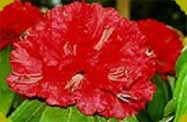|
Swertia chirata
Buch-Ham

|
Species |
Swertia chirata
Buch-Ham |
|
Local Name |
Chirata (Nep), Rungkyon (Lep) |
|
Synonym |
S.tonluensis
Burkill, Gentiana chirayita Roxb.ex Fleming
G. chirata Wall |
|
Family |
Gentianaceae |
|
Habitat |
It is a branched robust annual or perennial herb up to
1.5 m tall. The plant grows wild in temperate region.
The plant is found generally at cool and humid areas. |
|
Distribution |
Distributed in temperate-sub alpine region. |
|
Sikkim |
Chungthang, Dentam, Pemayantse, Kyongnosla, Rabong,
Bakhim to Tsokha, Karponang, 6th mile (East Sikkim),
Lachung-Sarchok, Nathang, Phadamchen, Dzongu. |
|
Out side |
Himachal Pradesh (Shimla, Chadwick
falls, Mushobra, Matiana, Jogindernagar) Utter Pradesh (Nainital,
Mussorie, Chopta, Binsar, Garnath, Jaunsar, Chakrata,
Tehri Garhwal, Ranikhet, Mandal, Chamoli); Nagaland (Naga
hills); West Bengal (Darjeeling); Meghalaya (Khasi
hills); also distributed in Nepal, Bhutan, Tibet and
China. |
|
General |
Himalayas (Kashmir-Bhutan), Meghalaya. |
|
Morphological |
Erect herb; up to 1.5 m tall. Roots
5-10 cm long, light brown, somewhat twisted and
gradually tapering. Stems more or less 4-sided. Leaves
opposite, broadly lanceolate, acute. Corymbose cymes.
Flowers greenish-yellow tinged with purple in. Capsules
sessile, oblong, many sided. Seeds smooth many angled.
|
|
Flowering |
September-November. |
|
Fruiting |
December |
|
History |
|
|
Parts |
Whole plant. |
|
Status |
Extinct in wild (Survived only through the cultivation) |
|
Phytochemistry |
Isolation and structure determination
of a new dimeric xanthone-chiratanin; a new triterpene-
swertanone isolated from aerial parts and its structure
elucidated. |
|
Agrocultivation |
|
|
Reference |
1. Chatterjee, Asima; Satyesh Chandra
Pakrashi (1995). The Treatise on Indian Medicinal
Plants, (Vol. 4). Publications and Information
Directorate, New Delhi. 92,94.
2. Kumar, Sushil; Janardan Singh;
N.C. Shah; Ranjan (1997). Indian Medicinal and Aromatic
Plants Facing Genetic Erosion. Central Institute of
Vinay Medicinal and Aromatic Plants, Lucknow. 193-195.
3. Kirtikar, K.R.; B.D. Basu (1994)
Indian Medicinal Plants (Vol. 1). Bishen Singh Mahendra
Pal Singh
Dehradun. 1664-1666.
4. Progress Report of the Project
"Studies on Medicinal Plants of Sikkim" (1998-2001).
State Council of Science and Technology for Sikkim.
5. Thakur, R.S. Puri, H.S. Hussain, Akhtar. (1989).
Major Medicinal Plants of India, Central Institute of
Medicinal and Aromatic Plants, Lucknow. 475-476. |
|
Medicinal |
Whole plant: Used as powder, infusion
or as an extract, antidiarrhoeal, antimalarial,
anthelmintic, astringent, bitter. Laxative, stomachic
and tonic used as a special remedy for franchial asthma
and liver disorders; beneficial in cough, dropsy,
dyspepsia, melancholia, sciatica and skin diseases;
given with sandal wood paste to stop internal
haemorrhage in the stomach. |
|
Ayurvedic |
It is an ingredient of ayurvedic "Chaturbhadra Kvatha" +
"Sudarshan churna", used for fevers. It is prescribed
with dry grapes and coriander in measles and in disease
of liver. |
|
Unani |
It is used in Jawarish jalanus for
weak digestion and urinary troubles. Roghan Kham as an
anti-inflammatory. |
|
Traditional |
The decoction of whole dried plant (around 200-250 ml)
taken daily in the morning before taking breakfast could
be the good remedies against high fever, cough and
malarial fever (Project Report 1999, Common System). The
root extract taken daily in the morning in an empty
stomach to keep fit and healthy. The juice of fresh
plants or infusion of dry plants is prescribed as blood
purifier in skin diseases, bitter tonic for fevers and
indigestion. The infusion prepared from chirayita. Dried
peels of orange and lemon and alcohol (25%) by
maceration official in I.P and its 0 dose is 2 to 4 ml. |
|
Others |
|
|
Prepartation |
|
|
Picture |
|
|
|
|
|

Rhododendron


Amongst the many
floral treaties of Sikkim Himalaya one of the earliest ones may be
found over the genus Rhododendron (Gk. rhodo = red, dendrons = tree
). |
| |
|
|
|

Orchid


Orchid
known for their brilliance in colors, unusual shapes
attractive growth habits, variety in fragrance and
exquisite beauty can attract any nature lovers.
|
| |
|
|
|

Medicinal Plant


Sikkim
with its total geographical area of 7,096 sq km is
bestowed with a huge diversity of flora and fauna.
|
| |
|
|
|
|
|